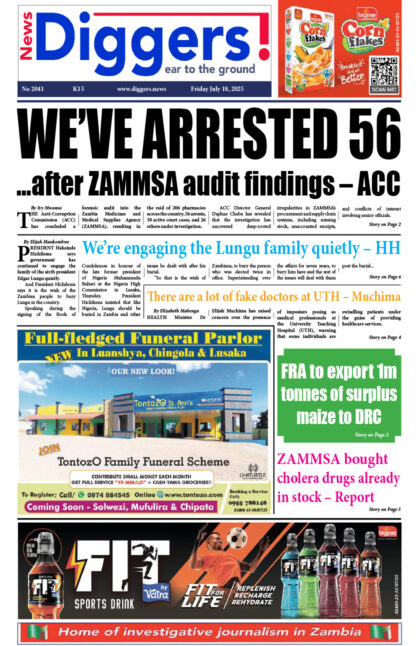THE International Monetary Fund (IMF) says the best way for Zambia to reduce its fiscal deficit is to tap into its domestic revenue potential and improve priority spending in a debt-free fashion.
And the IMF has projected that the country’s growth could contract by about five percent due the impact of the COVID-19 pandemic and the continued effect of the drought the country experienced during the 2018/2019 season.
Speaking during a webinar hosted by Consumer Unity Trust Society (CUTS) Zambia, Dr Dhaneshwar Ghura, the IMF Zambia team leader during the Fund’s recent virtual meeting, said despite Zambia’s ongoing fiscal pressures, the country still had huge potential to increase domestic revenues to spend on priority sectors without contracting debt.
“Once this current crisis subsides, policy would not be geared to re-orient fiscal policy, but to significantly lower the budget deficit while making fiscal space to scale up social and priority spending. The way to do that, of course, is to have a significant increase in domestic revenue. There is a lot of potential in Zambia to tap domestic revenues and that’s a good way to finance priority spending as we have been recommending to countries in a debt free fashion. So, the more of the domestic resources a country can mobilize, the less it has to rely on external loans,” Dr Ghura said.
“Zambia is a huge country with massive size and there are a lot of areas, which are sparsely populated regions so there needs to be access to these regions so the government has been investing massively in roads, infrastructure and bridges and so on. So, that is one. But a large part of these loans has been on concessional terms and as you know the cost of these types of loans are quite expensive, but what has happened also in Zambia is given the expensive nature of these loans over time, the debt service bill has grown, and in the absence of commensurate growth and revenue generation, a larger proportion of scarce resources have had to be used to be used to pay the external loans and, therefore, less available to Zambia for other priority spending. As a consequence, there has been a shortage of liquidity and also crowding out of the private sector.”
He advised the Zambian government to increase public spending in health and scale-up the Social Cash Transfer (SCT) programmes.
“So, the main area of support as we see them, that’s the advice we have been giving to countries across the board is to increase public spending in health, to scale-up social transfer programmes, that is installed basic social safety net. Zambia has actually a very nice social safety net framework in place and what is missing, of course, is financing for it. So, we have strongly encouraged the authorities to look into that and try to scale it up, the infrastructure is already there for the Social Cash Transfer programme, the framework from any indicators for scaling-up are there, all the elements are there in light of additional financing to scale it up. But, also, we have encouraged the government to supplement what it has already been doing in terms of temporary tax relief, to continue supporting the private sector. You know, the private sector is the lifeline, it is a sector that creates jobs in the country so you want to give that sector going post-COVID so the sector will remain there and be able to re-absorb employment and jobs,” Dr Ghura said.
“And we have all seen, all over countries, we are encouraging authorities to do all of that in a very transparent fashion, and the authorities have already started in this area of the use of COVID-related funds. So, what are the immediate government policy priorities in response to this COVID-19 crisis; Zambia is facing the situation from a very difficult starting point as I had laid out. In this context, your immediate priority is to implement measures to address the social, health and economic consequences. The government had introduced measures in this context in terms of help to the health sector, in terms of help to the private sector and also the central bank has been taking measures to help accentuate the impact of the COVID; it had eased the Monetary Policy (Rate) back in May, and it has also put in place a Medium-Term Refinancing Facility of about K10 billion to help financial institutions on-lend to the private sector and to individuals.”
And Dr Ghura observed that Zambia’s growth is expected to be worse than -4 per cent recorded last year in per capita terms.
“…But we also have to keep in mind that there was a major drought last year and the ripple effect of that still continues. Rainfall is normalizing, but this drought had a major impact on agriculture last year. As a result, as you know, growth was registered only at 1.4 per cent, which is, in per capita terms, growth was minus four per cent so this year is going to be even worse,” said Dr Ghura.



















